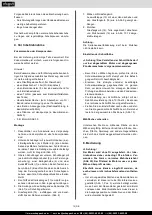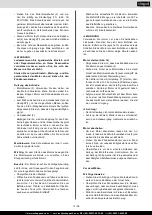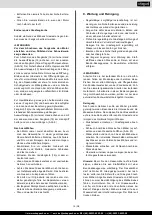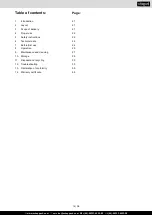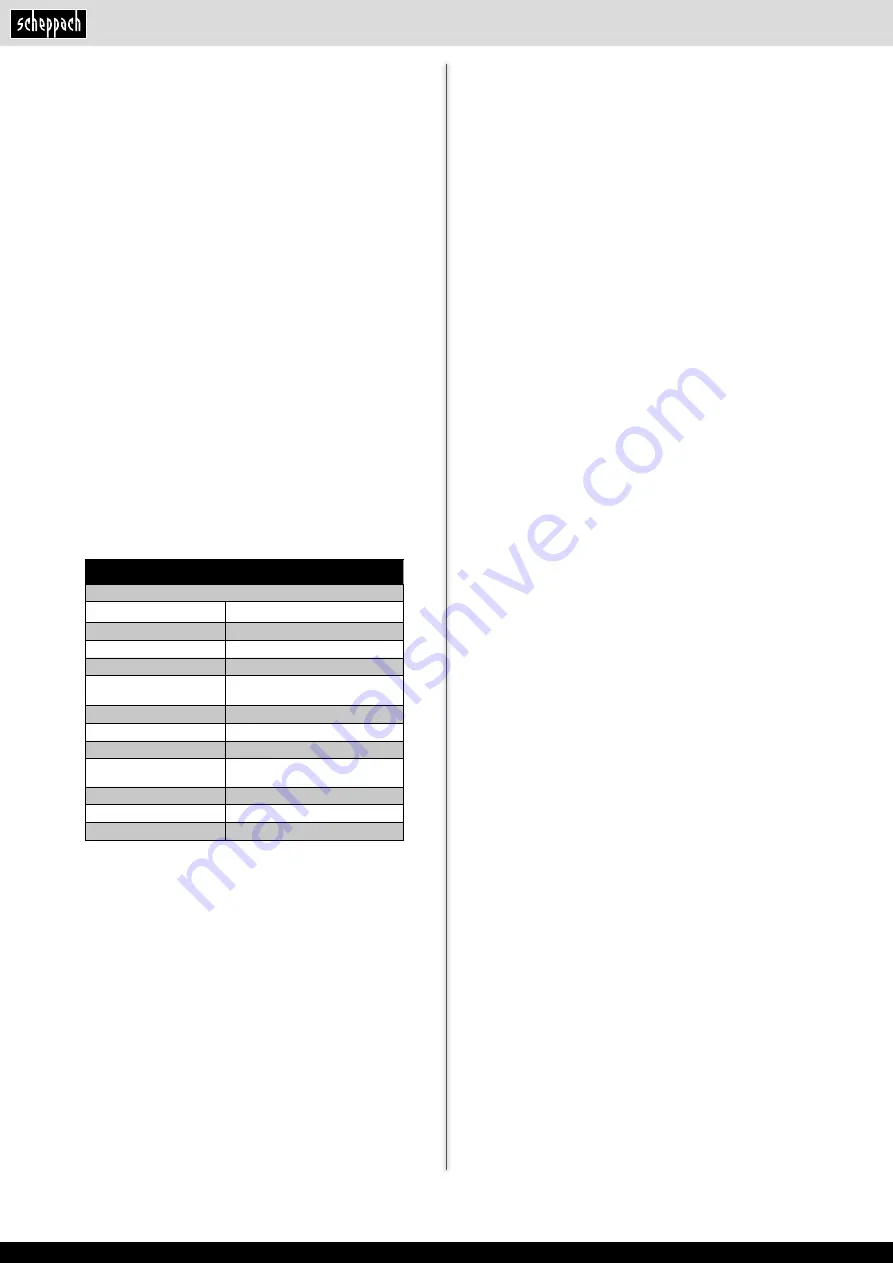
24 | GB
www.scheppach.com
+(49)-08223-4002-99
+(49)-08223-4002-58
www.scheppach.com
+(49)-08223-4002-99
+(49)-08223-4002-58
Residual risks and accident prevention stand-
ards
Neglect of ergonomic principles
Negligent handling of personal protective equip-
ment (PPE)
Negligent handling or ommission of the personal pro
-
tective equipment may cause serious injuries.
-
Wear prescribed personal protection equipment.
Human behaviour, misbehaviour
-
For any work be fully concentrated.
m
Residual risks
- Cannot be entirely excluded.
Danger from noise
hearing damage
Prelonged unprotected work with the device may
cause hearing damage.
-
Always wear ear-muffs.
In case of emergency
In case of a possibly occuring accident take the nec
-
essary first aid steps as appropriate and obtain quali
-
fied medical aid as quickly as possible.
6. Technical data
MS196-51
Technical data
Type engine
four stroke engine/air cooled
Cubic capacity
196 cm³
Rotation speed
2800 U/min
Max. engine output kW
4,4 kW /
6,0 HP
Fuel
Normalbenzin/Bleifrei max.
5% Bioethanol
Capacity tank
0,8 l
Motor oil
SAE 30 / 10W30
Capacity tank/oil
0,6 l
Cutting height
adjustment
25-75 mm / 7 -stages
Collection bag capacity
60 l
Cutting width
51 cm
Weight
35,0 kg
Subject to technical changes!
Information concerning noise emission measured ac-
cording to relevant standards:
Sound pressure L
pA
= 83,2 dB(A)
Uncertainty K
PA
= 2,5 dB(A)
Sound power L
WA
= 95,9 dB(A)
Uncertainty K
PA
= 0,61 dB(A)
Wear ear-muffs.
The impact of noise can cause damage to hearing.
Vibration A
hv
(left/right) = 6,36 m/s
2
Uncertainty K
PA
= 1,5 m/s
2
Reduce noise generation and vibration to a minimum!
•
Use only equipment that is in perfect condition.
•
Maintain and clean the equipment regularly.
•
Adopt your way of working to the equipment.
•
Do not overload the equipment.
•
Have the equipment checked if necessary.
•
Switch off the equipment when not in use.
• Wear gloves.
When using the petrol lawn mower for extended peri
-
ods, vibration-induced circulatory problems may oc
-
cur (white finger disease).
We cannot give exact details about the duration of
use in this case because it is different for each indi
-
vidual.
The following factors can influence the condition:
•
Circulatory problems in the user’s hands
•
Low outside temperatures
•
Extended periods of use
We therefore recommend you wear warm work gloves
and take regular breaks.
7. Before first use
Assembling the components
Some parts of the mower come disassembled. For
quick and easy assembly, read and follow the instruc
-
tions below.
Important!
You will need the following additional tools (not sup
-
plied) for assembly, and also for maintenance work:
•
A 1 liter measuring jug (oil/petrol resistant)
•
A petrol can (5 liters is sufficient for approx. 6 op
-
erating hours)
•
A funnel (suitable for the tankʼs petrol filler neck)
•
Household wipes (to wipe up oil/petrol residue; dis
-
pose of these at a filling station)
•
A petrol suction pump (plastic, available from DIY
stores)
•
An oil can with hand pump (available from DIY
stores)
•
0,6 liter of engine oil (SAE 30)
Assembly
1.
Take the mower and attachment parts out of the
packaging and check that all parts are present.
2.
Attach the lower push bar to both sides of the
mower with two screws (a, e), 2 washer (b), 2
hexagon nut (c) (d) each. Make sure that the ca
-
bles, which will be attached later, are not in the
way (Fig. 2-3).
3.
Attach the upper push bar on the lower push bar
with one quick-release lever (5), one fixation slice
(g), one washer (b) and one plastic nut (f) each on
both sides (Fig. 4-5). Note the correct alignment
of the quick-release lever fixation slice ensuring
the quick-release function remains intact.
4.
Insert the pull start handle (17) in the designated
hook as shown in Fig. 6.



